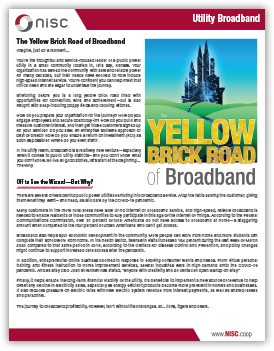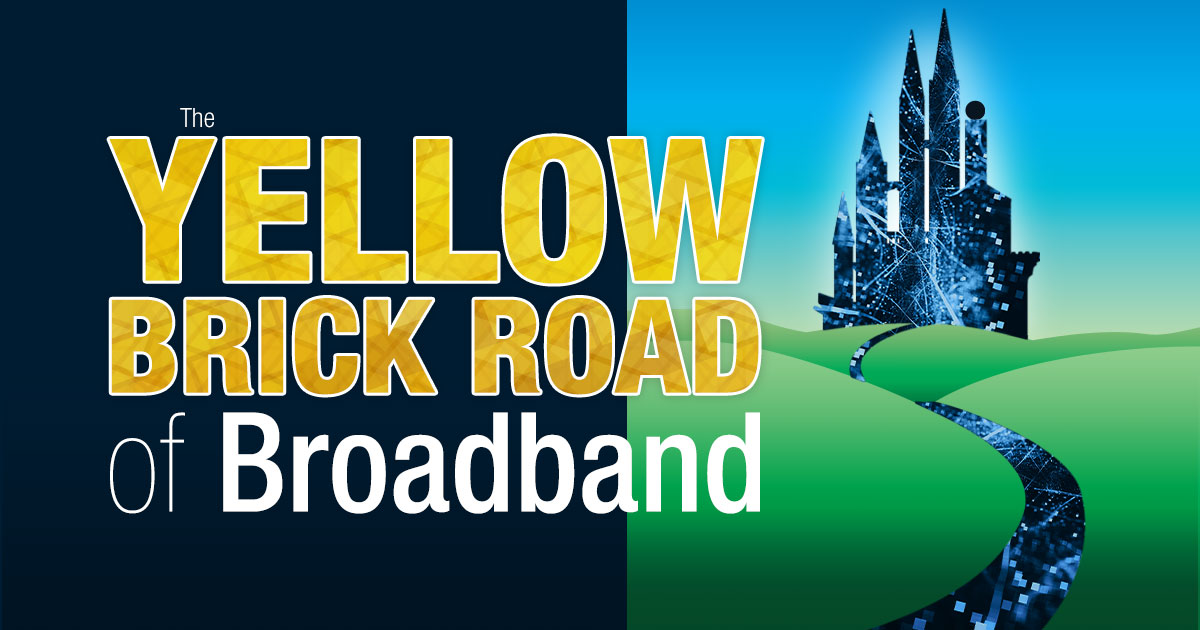Imagine, just for a moment…
You’re the thoughtful and service-focused leader of a public power utility in a small community located in, let’s say, Kansas. Your organization has served the community with safe and reliable power for many decades, but their needs have evolved to now include high-speed internet service. You’re confident you can help meet that critical need and are eager to undertake the journey.
Stretching before you is a long yellow brick road lined with opportunities for connection, wins and achievement—but is also fraught with sleep-inducing poppy fields and cackling witches.
How do you prepare your organization for the journey? How do you engage employees and secure board buy-in? How do you build and measure customer interest, and then get those customers signed up for your service? Do you seek an enterprise software approach or best of breed? How do you ensure a return on investment (ROI) as soon as possible? Where do you even start?
In the utility realm, broadband is a relatively new venture—especially when it comes to public utility districts—and you don’t know what you don’t know. So like all good stories, let’s start at the beginning… The Why.
 |
| Click here to download |
Off to See the Wizard—But Why?
There are several drivers behind public power utilities venturing into broadband service. Atop the list is serving the customer: giving them what they want—and need, as laid bare by the COVID-19 pandemic.
Many customers in the more rural areas have slow or no internet or broadband service, and high-speed, reliable broadband is needed to enable residents of those communities to fully participate in this age of the Internet of Things. According to the Federal Communications Commission, over 31 percent of rural Americans do not have access to broadband at home—a staggering amount when compared to the four percent of urban Americans who can’t get access.
Broadband also helps spur economic development in the community. More people can work from home and more students can complete their schoolwork from home. In the health sector, telehealth visits increased 154 percent during the last week of March 2020 compared to that same period in 2019, according to the Centers for Disease Control and Prevention, and policy changes might continue to support increased care access after the pandemic.
In addition, entrepreneurial online business boomed in response to evolving consumer wants and needs. From virtual personal training and fitness instruction to home improvement services, several industries were in high demand amid the COVID-19 pandemic. And as Etsy CEO Josh Silverman has stated, “anyone with creativity and 20 cents can open a shop on Etsy.”
Finally, it helps ensure the long-term financial viability of the utility. It’s beneficial to implement a new source of revenue to help offset any decline in electricity sales, especially as energy efficient products become more prevalent in homes and businesses. It also reduces pressure on electric rates with new electric system revenue from interest payments, as well as shared leases and personnel.
The journey to broadband profitability, however, isn’t without its challenges. Er… lions, tigers and bears.
Lions, Tigers, Bears, etc.
Your organization will want to see an ROI on the project as soon as possible, and there are significant costs that accrue in the early going. Phasing in the program over several years allows the new broadband division to generate revenue that helps cover the capital costs of the build-out.
In addition, reaching rural areas can be logistically difficult. Some public power utilities have found success employing a hybrid approach to broadband—offering fiber optic service in urban areas and broadcasting high-speed wireless broadband service in the more rural areas of its service territory. In the case of one public utility district, tests showed the WiFi could cover up to six miles at good speeds, and technology is improving by the day.
And then there’s marketplace unfamiliarity. After providing reliable electric service for years, broadband is a new type of marketplace for the utility, and the utility must learn to compete for business. The industry is full of competition from incumbent providers* with years of experience in a competitive field. (*“Flying monkeys” may be used for the purposes of this discussion. We suggest, however, that such terminology be kept exclusively to internal discussions.)
Engage Customers—and Their Little Dog, Too
To successfully launch and maintain broadband service, customer engagement is key. Below are some critical considerations for your utility.
Multichannel Messaging – Building and establishing connections in your community all starts with communication. Every customer is different and reaching those customers can be challenging. It’s important to engage these customers where they are and how they prefer, whether they want text messages, push notifications, phone calls or even a printed letter.
Pre-Registration for Service – Apps, websites, and now broadband and utility organizations are tapping into user-centric technology with the functionality to do full crowdsourcing to help drive their business forward. But what is crowdsourcing? And more importantly, why would you want to use it?
At its core, crowdsourcing is simply bringing together a large group of people to help divide and conquer a particular project. The concept isn’t new to broadband and utility organizations. Many rural broadband and utility companies, such as rural electric cooperatives in the 1930s and ‘40s, were formed by communities coming together and deciding to do something to fill a need. In 2021, broadband and utility companies are still relying on their customers for help for projects such as broadband rollouts and implementation of new programs and services.
A crowdsourcing solution for pre-signup can help gauge interest and get customers excited to tell others in their area about the product, measure leads and create customer behavioral profiles using crowdsourcing data. Then you can leverage that data to launch a targeted marketing campaign.
If you’re rolling out a new service or program, crowdsourcing can help you get an idea where to start and where to spend your time. A solid pre-registration solution starts by allowing you to establish zones in your territory. Once the zones are established, you can spread the word about your new service or project allowing customers to sign up.
The customers won’t help bury fiber line or put up poles, but they can help you understand how to best roll out your solution, both for efficiency and to help maximize the ROI of extremely important projects.
Managing Customer Expectations – Ultimately, customer satisfaction is key. While fixed wireless broadband service providers focus largely on delivering the broadband services to the home across their wireless access network, they often overlook the equally challenging and oftentimes more complex delivery of those services inside the home wireless network—which can be detrimental to the customer experience.
Deploying a solution that supports remote home network management has become critical with the explosion of WiFi connected devices. The most successful service providers will deliver unmatched customer service enabled by a robust remote customer care solution. The best solution gives providers visibility into the customer home network, allowing a review of the state and performance of devices connected via WiFi to the carrier’s broadband network. Ideally, service providers will have the ability to monitor networks and proactively address issues before the customer even realizes there is one.
You can also make life easy on the customer, and more streamlined for your utility by providing voice assistant functionality. This would allow utility consumers to use their voice to interact with their utility provider to complete tasks such as check their account balance and news updates, get payment history, check outage information and make payment, all via a Google Home or Amazon Echo.
There’s No Place Like Home Connectivity
Congratulations! You have successfully outmaneuvered the monkeys and exhibited plenty of brains, heart and courage along your journey to providing your community critical access to broadband connectivity.
NISC has decades of experience in both the utility and telecommunications industries, and have rolled that experience into our fully integrated Enterprise System. NISC’s existing utility-based Service solutions effectively manages electric, water, gas and more traditional utility services, as well as enables management and provisioning of broadband and cable solutions, all on a single platform.
In addition, NISC’s web and mobile app provides easy-to-understand bill and account management, while also empowering customers to report service issues and outages through the app or via text message, manage their WiFi networks to maximize speed, receive important info in their preferred communications channel and receive important updates. Voice assistant functionality allows users to utilize their Amazon Echo or Google Home devices to talk to their utility and perform a variety of tasks like check account balance and news updates, get payment history, check outage information and make a payment, just as they would on the app.
What does your utility look like in the next 10, 20 years? Do you consider other fiber-backed services in addition to internet, including phone, streaming film, and TV content to provide to your growing base of broadband customers?
Embarking on a broadband project can feel like a leap into the great unknown for your utility, but it doesn’t need to be so daunting. Through collaboration and innovation, your utility can continue its legacy of service and effectively meet your customers’ ever-evolving needs.
No ruby slippers required.
